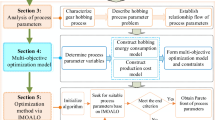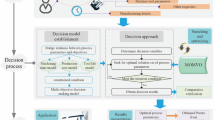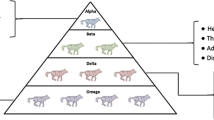Abstract
Manufacturing industry has paid more attention to the carbon footprint in the manufacturing process with an increasing focus on ecological environment. Also, optimum machining parameters are usually considered as an efficient solution for minimizing carbon footprint and processing time owing to their great role in process control. To make a better process parameter set, a novel multi-objective parameter decision approach called multi-objective grey wolf optimizer (MOGWO) is adopted to realize the decision process in gear hobbing. First, the problem of gear production is elaborated in detail and the characteristics of carbon footprint in light of hobbing process are synthetically analyzed; the carbon footprint model and processing time model are established subsequently. Second, a parameter decision approach for multi-objectives is presented followed by thorough optimization approach. Finally, a case study is put into practice for verifying the presented parameter decision-making scheme. The results demonstrate good hobbing process parameter solutions under the proposed decision approach, and it reveals a certain functional relationship between carbon footprint and processing time in view of the graphic display.








Similar content being viewed by others
References
Zhou G, Lu Q, Xiao Z, Zhou C, Tian C (2019) Cutting parameter optimization for machining operations considering carbon emissions. J Clean Prod 208:937–950
Hu L, Liu Y, Chen P, Tang W, Tang R, Tiwari A (2018) Minimising the energy consumption of tool change and tool path of machining by sequencing the features. Energy 147:390–402
Gupta K, Jain NK (2014) Comparative study of wire-EDM and hobbing for manufacturing high-quality miniature gears. Mater Manuf Process 29:1470–1476
Xiao Q, Li C, Tang Y, Li L, Li L (2019) A knowledge-driven method of adaptively optimizing process parameters for energy efficient turning. Energy 166:142–156
Miranda J, Camposeco-Negrete C, Calderón J (2016) Optimization of cutting parameters to minimize energy consumption during turning of AISI1018 steel at constant material removal rate using robust design. Int J Adv Manuf Technol 83:1341–1347
Lin W, Yu DY, Zhang C, Liu X, Zhang S, Tian Y, Liu S, Xie Z (2015) A multi-objective teaching−learning-based optimization algorithm to scheduling in turning processes for minimizing makespan and carbon footprint. J Clean Prod 101:337–347
Lin W, Yu DY, Wang S, Zhang C, Zhang S, Tian H, Luo M, Liu S (2015) Multi-objective teaching–learning-based optimization algorithm for reducing carbon emissions and operation time in turning operations. Eng Optim 47:994–1007
Yi Q, Li C, Tang Y, Chen X (2015) Multi-objective parameter optimization of CNC machining for low carbon manufacturing. J Clean Prod 95:256–264
Wang QL, Liu F, Wang XL (2014) Multi-objective optimization of machining parameters considering energy consumption. Int J Adv Manuf Technol 71(5-8):1133–1142
Zhang Z, Wu L, Jia S, Peng T (2020) Multi-objective parameter optimization to support energy-efficient peck deep-hole drilling processes with twist drills. Int J Adv Manuf Technol (9-12)
Kant G, Sangwan K (2014) Prediction and optimization of machining parameters for minimizing power consumption and surface roughness in machining. J Clean Prod 83:151–164
Yan J, Li L (2013) Multi-objective optimization of milling parameters – the trade-offs between energy, production rate and cutting quality. J Clean Prod 52:462–471
Alrashdan A, Bataineh O, Shbool M (2014) Multi-criteria end milling parameters optimization of AISI D2 steel using genetic algorithm. Int J Adv Manuf Technol 73(5-8):1201–1212
Jagadish RA (2016) Optimization of process parameters of green electrical discharge machining using principal component analysis (PCA). Int J Adv Manuf Technol 87:1299–1311
Adalarasan R, Sundaram AS (2015) Parameter design and analysis in continuous drive friction welding of Al6061/SiCp composites. J Mech Sci Technol 29(2):769–776
Jeswiet J, Kara S (2008) Carbon emissions and CES™ in manufacturing. CIRP Ann-Manuf Technol 57:17–20
Song JS, Lee KM (2010) Development of a low-carbon product design system based on embedded GHG emissions. Resour Conserv Recycl 54:547–556
Li C, Tang Y, Cui L, Li P (2015) A quantitative approach to analyze carbon emissions of CNC-based machining systems. J Intell Manuf 26:911–922
Zhou GH, Zhou C, Lu Q, Tian C, Xiao Z (2018) Feature-based carbon emission quantitation strategy for the part machining process. Int J Comput Integr Manuf 31(4-5):406–425
Zhou G, Yuan S, Lu Q, Xiao X (2018) A carbon emission quantitation model and experimental evaluation for machining process considering tool wear condition. Int J Adv Manuf Technol 98:565–577
Gui F, Ren S, Zhao Y, Zhou J, Xie Z, Xu C, Zhu F (2019) Activity-based allocation and optimization for carbon footprint and cost in product lifecycle. J Clean Prod 36:117627
Lu Q, Zhou GH, Xiao ZD, Chang FT, Tian CL (2018) A selection methodology of key parts based on the characteristic of carbon emissions for low-carbon design. Int J Adv Manuf Technol 94:3359–3373
Zhou G, Tian C, Zhang J, Chang F, Lu Q (2018) Multi-objective process route optimization considering carbon emissions. Int J Adv Manuf Technol 96:1195–1213
Xiao Q, Li C, Tang Y, Pan J, Yu J, Chen X (2019) Multi-component energy modeling and optimization for sustainable dry gear hobbing. Energy 187:115911
Zhang Y, Cao HJ, Chen P, Zhu LB, Yang X (2017) An adaptive parameter optimization model and system for sustainable gear dry hobbing in batch production. J Mech Sci Technol 31:2951–2960
He B, Huang S, Wang J (2015) Product low-carbon design using dynamic programming algorithm. Int J Pr Eng Man-GT 2:37–42
Cai W, Liu F, Hu S (2018) An analytical investigation on energy efficiency of high-speed dry-cutting CNC hobbing machines. Int J Sustain Eng 11:412–419
Cao WD, Yan CP, Wu DJ, Tuo JB (2017) A novel multi-objective optimization approach of machining parameters with small sample problem in gear hobbing. Int J Adv Manuf Technol 93:1–12
Sabkhi N, Moufki A, Nouari M, Pelaingre C, Barlier C (2016) Prediction of the hobbing cutting forces from a thermomechanical modeling of orthogonal cutting operation. J Manuf Process 23:1–12
Wang SL, Yang Y, Zhou J, Li Q, Yang S, Kang L (2011) Effect of machining precision caused by NC gear hobbing deformation. Appl Mech Mater 86:692–695
Mirjalili S, Mirjalili SM, Lewis A (2014) Grey wolf optimizer. Adv Eng Softw 69:46–61
Mirjalili S, Saremi S, Mirjalili SM, Coelho LS (2015) Multi-objective grey wolf optimizer: a novel algorithm for multi-criterion optimization. Expert Syst Appl 47:106–119
Ai X, Xiao S (1994) Brief manual of cutting parameters. China Machine Press, Beijng (in Chinese)
Chen X, Li C, Tang Y, Xiao Q (2018) An Internet of Things based energy efficiency monitoring and management system for machining workshop. J Clean Prod 199:957–968
Acknowledgments
This work was supported by the Key Projects of Strategic Scientific and Technological Innovation Cooperation of National Key R&D Program of China (No. 2020YFE0201000).
Author information
Authors and Affiliations
Corresponding author
Additional information
Publisher’s note
Springer Nature remains neutral with regard to jurisdictional claims in published maps and institutional affiliations.
Rights and permissions
About this article
Cite this article
Ni, H., Yan, C., Cao, W. et al. A novel parameter decision approach in hobbing process for minimizing carbon footprint and processing time. Int J Adv Manuf Technol 111, 3405–3419 (2020). https://doi.org/10.1007/s00170-020-06103-1
Received:
Accepted:
Published:
Issue Date:
DOI: https://doi.org/10.1007/s00170-020-06103-1




